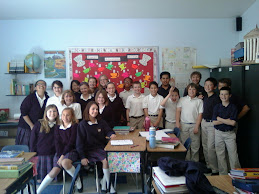Last week we began reading Gilgamesh, one of the oldest pieces of literature in the world. Though we are reading the story as part of our Language Arts program it also, of course, ties in with our Social Studies unit on Mesopotamia.
The students had read up through Chapter Four this morning (there are a total of twelve chapters), and, per the usual, I asked them to tell me about the chapter, as they remembered/understood it.
Following the chapter re-cap, each student was asked to go through the first four chapters and to write down what they thought the three main events were from each chapter thus far. Once they completed their lists, they worked in groups of four to narrow it down to the one main event that would truly capture the essence of each chapter.
Next, in their groups, each student had to choose one of the chapter "events," and write it out in a clear, complete sentence. Then they had to draw the event using only a pencil. Tomorrow they will complete the other two parts of that activity. I can't tell you what those are now - for the students aren't supposed to know what they are doing ahead of time - but it does have to do with "layering," and the idea that stories have many layers - i.e. in the story itself; in the re-telling of a story; because of language translations, etc.
This afternoon we had an all-class review for our Science test this coming Wednesday, done in a pseudo-Jeopardy-style format. And the students also were given in-class time to work on their Stone Age Board Game project which is due for presentation on Thursday.
Vocabulary and Social Studies tests were sent home today to be signed by parents and should be returned tomorrow. Tests are a terrific indicator for gaging where students are "at" in their understanding/retention of the information they are learning, but they are not the be-all/end-all.
As the end of the first quarter approaches, Mrs. Veenstra and I are in the midst of assessing what is working best for this group of students and what kind of changes we can begin to implement in the upcoming second quarter
And that, folks, is my story. And I'm sticking to it!
Cheers,
Ms. Pitman
skip to main |
skip to sidebar

This doesn't happen very often...

Room 503: All Present and Accounted For.
Welcome to the Tempe Prep Junior Academy (TPJA) Sixth Grade Blog. This blog serves as a communication tool for teachers and parents - offering daily homework postings,weekly updates on our academic and creative classroom adventures, and providing postings of any upcoming events to look out for.
Together Again!

This doesn't happen very often...
All Together Now!

Room 503: All Present and Accounted For.
Blog Archive
-
▼
2008
(184)
-
▼
September
(57)
- HOMEWORK, Tuesday, September 30, 2008
- And the Story Continues...
- Every Student Tells a Story
- HOMEWORK, Monday, September 29, 2008
- Will Post Later
- HOMEWORK, Friday, September 26, 2008
- Trip Slips
- HOMEWORK, Thursday, September 25, 2008
- Around the Box Thinking
- HOMEWORK, Wednesday, September 24, 2008
- Broaden Your Vocabulary...
- Testing...One, Two, Three...
- HOMEWORK, Tuesday, September 23, 2008
- Gone Fishing...
- HOMEWORK, Monday, September 22, 2008
- Independence Day
- Life on Ixchel...Muted & In Color
- Life on Ixchel...Muted & In Color
- Life on Ixchel...Muted & In Color
- Life on Ixchel...Muted & In Color
- Life on Ixchel...Muted & In Color
- Life on Ixchel...Muted & In Color
- Life on Ixchel...Muted & In Color
- Life on Ixchel...Muted & In Color
- Life on Ixchel...Muted & In Color
- HOMEWORK, Friday, September 19, 2008
- Tea for Two + 19 More
- HOMEWORK, Thursday, September 18, 2008
- Picture This:
- HOMEWORK, Wednesday, September 17, 2008
- The Art of Language Arts
- HOMEWORK, Tuesday, September 16, 2008
- Batteries Not Included
- HOMEWORK, Monday, September 15, 2008
- Mesopotamian Geckos & Crested Cuneiform
- HOMEWORK, Friday, September 12, 2008
- Friday Free-For-All!
- HOMEWORK, Thursday, September 11, 2008
- There's History, Herstory, and Today: Therestory!
- HOMEWORK, Wednesday, September 10, 2008
- Basic Training
- HOMEWORK, Tuesday, September 9, 2008
- Knot Our Average Day
- Mrs. Whatsit, Mrs. Who and Mrs. Which
- Mrs. Whatsit, Mrs. Who and Mrs. Which
- Mrs. Whatsit, Mrs. Who and Mrs. Which
- Mrs. Whatsit, Mrs. Who and Mrs. Which
- HOMEWORK, Monday, September 8, 2008
- A Tale of TWENTY Rivers
- HOMEWORK, Friday, September 5, 2008
- Fun on Friday
- HOMEWORK, Thursday, September 4, 2008
- An EGGStraordinary Day!
- HOMEWORK, Wednesday, September 3, 2008
- We're Booked!
- HOMEWORK, Tuesday, September 2, 2008
- Comma-ments on a Monday
-
▼
September
(57)